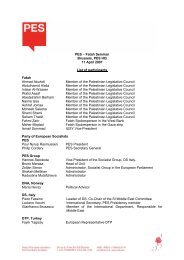Hedge funds and Private Equity - PES
Hedge funds and Private Equity - PES
Hedge funds and Private Equity - PES
Create successful ePaper yourself
Turn your PDF publications into a flip-book with our unique Google optimized e-Paper software.
94<br />
3. A Member State may entrust management <strong>and</strong> labour, at their joint request, with the<br />
implementation of directives adopted pursuant to paragraph 2.<br />
In this case, it shall ensure that, no later than the date on which a directive must be transposed<br />
in accordance with Article 249, management <strong>and</strong> labour have introduced the<br />
necessary measures by agreement, the Member State concerned being required to take<br />
any necessary measure enabling it at any time to be in a position to guarantee the results<br />
imposed by that directive.<br />
4. The provisions adopted pursuant to this article:<br />
shall not affect the right of Member States to define the fundamental principles of their<br />
social security systems <strong>and</strong> must not significantly affect the financial equilibrium<br />
thereof,<br />
shall not prevent any Member State from maintaining or introducing more stringent<br />
protective measures compatible with this Treaty.<br />
5. The provisions of this article shall not apply to pay, the right of association, the right to<br />
strike or the right to impose lock-outs.<br />
3.6 Supervision<br />
The Directive 2002/87/EC on the supplementary supervision of credit institutions, insurance<br />
undertakings <strong>and</strong> investment firms in a financial conglomerate introduces group-wide supervision<br />
of financial conglomerates <strong>and</strong> requires closer co-operation <strong>and</strong> information sharing among<br />
supervisory authorities across sectors. The directive also introduces initial steps to align the rules<br />
for financial conglomerates with those for homogeneous financial groups (dealing in a single<br />
financial sector, such as banking) so as to ensure equivalence of treatment <strong>and</strong> a level playing<br />
field.<br />
One can imagine using the framework of this Directive to supervise the activities of banks acting<br />
as intermediaries for the alternative investment industry. In that case, the Capital adequacy<br />
requirement directive (CRD) would be one tool. But in general, any thorough supervision of the<br />
<strong>funds</strong> themselves would require a specific regulatory framework because their characteristics<br />
differ from those of credit institutions or insurance companies. The national authorities would be<br />
the competent ones in this area, within the cooperation framework of CESR (Committee of European<br />
securities regulators).<br />
The previous (1988) Basel Accord constitutes the international benchmark for capital<br />
adequacy <strong>and</strong> is agreed by the G-10 banking supervisors in the Committee on Banking Supervision<br />
of the Bank for International Settlements (known as the Basel Committee). Like the<br />
Basel Committee’s rules, the new EU capital st<strong>and</strong>ards aim to align regulatory capital requirements<br />
more closely with underlying risks <strong>and</strong> to provide institutions with incentives to move to<br />
higher st<strong>and</strong>ards of risk management. The Directive (CRD), which is one of the outst<strong>and</strong>ing<br />
measures required to complete the EU Financial Services Action Plan, will modernise the




